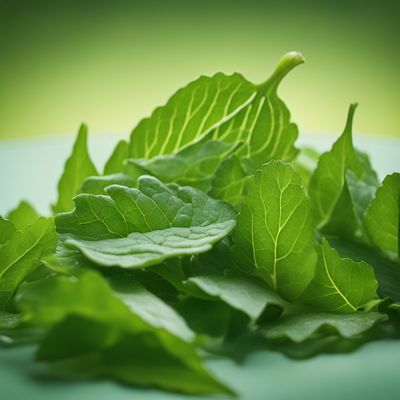
Ingredient
Jew's mallow leaves
The Nutritional Powerhouse: Jew's Mallow Leaves
Jew's mallow leaves are dark green, heart-shaped leaves that grow on the jute plant. They have a slightly slimy texture when cooked, similar to okra, and a mild, earthy flavor. These leaves are rich in vitamins A, C, and E, as well as minerals like iron and calcium. They are often used in soups, stews, and stir-fries, adding a unique taste and texture to dishes.
Origins and history
Jew's mallow leaves have a long history and are believed to have originated in ancient Egypt. They have been cultivated and consumed in various parts of the world, including the Middle East, North Africa, and Asia, for centuries. These leaves hold cultural significance in many cuisines and are often associated with traditional dishes.
Nutritional information
Jew's mallow leaves are packed with essential nutrients, including vitamins A, C, and E, which support immune function and promote healthy skin. They are also a good source of iron, calcium, and fiber, making them beneficial for maintaining bone health and aiding digestion.
Allergens
There are no known allergens associated with Jew's mallow leaves.
How to select
When selecting Jew's mallow leaves, look for fresh, vibrant green leaves that are free from yellowing or wilting. Avoid leaves with brown spots or signs of decay. Opt for leaves that are firm and not overly mature, as they tend to become tougher and less flavorful.
Storage recommendations
To maintain the freshness of Jew's mallow leaves, store them in a plastic bag or airtight container in the refrigerator. They can stay fresh for up to a week. Alternatively, you can blanch and freeze the leaves for longer storage.
How to produce
Jew's mallow leaves can be grown in a home garden or container. Start by planting jute seeds in well-draining soil and provide ample sunlight and water. Harvest the leaves when they are young and tender for the best flavor and texture.
Preparation tips
Before using Jew's mallow leaves, wash them thoroughly to remove any dirt or debris. Remove the tough stems and chop the leaves into desired sizes. These leaves are commonly used in soups, stews, and stir-fries, where they add a unique flavor and texture. They can also be sautéed or blanched and used as a nutritious addition to salads.
Substitutions
Spinach or kale can be used as substitutes for Jew's mallow leaves, although they may not provide the same slimy texture. N/A
Culinary uses
Jew's mallow leaves are commonly used in Middle Eastern, North African, and Asian cuisines. They are often added to soups, such as Egyptian molokhia soup, or used in stews and curries. These leaves can also be stir-fried with garlic and spices or used as a filling for savory pies and pastries.
Availability
Jew's mallow leaves are commonly available in regions such as the Middle East, North Africa, and parts of Asia. They can also be found in specialty grocery stores or ethnic markets in other countries.
More ingredients from this category » Browse all

Scurvy-grass
The Citrusy Herb

Plantain leaves
Versatile Wrapping Material

Nightshade, black
The Dark Delight: Unveiling the Secrets of Black Nightshade

Mallow leaves
Velvety Greens with a Mild Bite

Papaya leaves
The Healing Green

Salsify leaves
The Verdant Delight: Unveiling the Hidden Potential of Salsify Leaves

Taro leaves
The Verdant Delicacy: Taro Leaves

Sowthistle leaves
Vibrant Greens Packed with Nutrients

Blackjack leaves
The Versatile Blackjack

Balsam pear leaves
The Healing Power of Balsam Pear Leaves

Box thorn
Nature's Tang

Pumpkin leaves
The Nutritious Greens: Pumpkin Leaves

